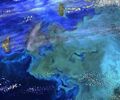File:Plankton Phytoplankton--'Climate Dance'.jpg: Difference between revisions
Siterunner (talk | contribs) No edit summary |
Siterunner (talk | contribs) No edit summary |
||
| Line 2: | Line 2: | ||
NASA Ocean Satellite Data Shows ‘Climate Dance’ of Plankton | '''NASA Ocean Satellite Data Shows ‘Climate Dance’ of Plankton''' | ||
Marine Food Chain | |||
The greens and blues of the ocean color from NASA satellite data have provided new insights into how climate and ecosystem processes affect the growth cycles of phytoplankton—microscopic aquatic plants important for fish populations and Earth’s carbon cycle. | The greens and blues of the ocean color from NASA satellite data have provided new insights into how climate and ecosystem processes affect the growth cycles of phytoplankton—microscopic aquatic plants important for fish populations and Earth’s carbon cycle. | ||
Revision as of 20:27, 4 May 2015
NASA Ocean Satellite Data Shows ‘Climate Dance’ of Plankton
Marine Food Chain
The greens and blues of the ocean color from NASA satellite data have provided new insights into how climate and ecosystem processes affect the growth cycles of phytoplankton—microscopic aquatic plants important for fish populations and Earth’s carbon cycle.
At the bottom of the ocean’s food chain, phytoplankton account for roughly half of the net photosynthesis on Earth. Their photosynthesis consumes carbon dioxide and plays a key role in transferring carbon from the atmosphere to the ocean. Unlike the plant ecosystems on land, the amount of phytoplankton in the ocean is always followed closely by the abundance of organisms that eat phytoplankton, creating a perpetual dance between predators and prey.
This new analysis shows how tiny imbalances in this predator-prey relationship, caused by environmental variability, give rise to massive phytoplankton blooms, having huge impacts on ocean productivity, fisheries and carbon cycling. The study was released Thursday, Sept. 25, in the journal Nature Climate Change.
“The continuous year-in and year-out measurements provided by NASA’s ocean color satellites have dramatically changed our understanding of phytoplankton dynamics on the Earth,” said Mike Behrenfeld, author of the study and phytoplankton ecologist at Oregon State University, Corvallis, Oregon. “What we now see is a closely linked system of phytoplankton cell division and consumption lying at the heart of the plant’s annual cycle.”
Behrenfeld calls this close predator-prey relationship the “Dance of the Plankton.” This view is different from previous perspectives that have simply focused on environmental resources used by phytoplankton to grow, such as nutrients and light. The new view is important because it reveals that tiny imbalances can greatly impact Earth’s ecology.
Read more: 1.usa.gov/ZkVMHG
Credit: NASA's Goddard Space Flight Center, Norman Kuring; USGS
+NASA Goddard
+USGS News:Mapping, Remote Sensing, Geospatial Data #NASA #Satellite #Earth #Ocean #Phytoplankton #Biology #Life #Climate #Ecosystem #Science #CarbonCycle #Aquatic #Photosynthesis
File history
Click on a date/time to view the file as it appeared at that time.
| Date/Time | Thumbnail | Dimensions | User | Comment | |
|---|---|---|---|---|---|
| current | 20:18, 4 May 2015 |  | 773 × 644 (161 KB) | Siterunner (talk | contribs) | Category:Green Graphics |
You cannot overwrite this file.
File usage
The following 16 pages use this file:
- Book Reviews @GreenPolicy
- Citizen Science
- Earth Science Research from Space
- Earthviews from Astronauts
- Ecolivia
- GreenPolicy360 Archive Highlights 2015
- TinyBlueGreen
- File:Earths two lungs.png
- File:Phytoplankton.jpg
- File:Sylvia Earle quote.png
- File:The World Is Blue.jpg
- Category:Earth Observations
- Category:Microbiology
- Category:Ocean Ecosystem
- Category:Oceans
- Category:Planet Citizens, Planet Scientists
- Green Graphics
- Biodiversity
- Earth360
- Earth Observations
- Earth Science
- Ecology Studies
- Environmental Full-cost Accounting
- Environmental Security, National Security
- EOS eco Operating System
- Externalities
- ISS
- Land Ethic
- Planet Citizen
- Planet Scientist
- Planet Citizens, Planet Scientists
- Sustainability
- Sustainability Policies
- Biogeosciences
- Climate Change
- Geophysics and Geochemistry
- Hydrology
- Natural Resources
- Oceans
- Ocean Science